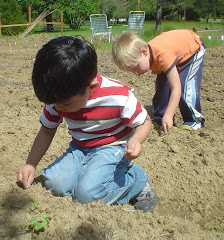 |
| Planted side-beds in a previous greenhouse that Chris built and managed. |
The challenge: In our 100-foot-long greenhouse we've got two side-beds that still have living grass growing in them. Since we began building the greenhouse at the start of Oregon's rainy season we didn't want to roto-till the ground which would have created a muddy mess during construction-time. We have begun a process now which we hope will leave us with healthy, worm-filled beds in time for this next summer's plantings of tomatoes, peppers and other herbs and vegetables.
 |
| Creating raised beds with salvaged lumber. |
The Solution: Step 1: We used salvaged lumber to create the sides of the raised beds. As we build the soil, this will contain it from spilling into the paths. Each bed is four feet wide.
Step 2: With leaves that people have donated, we lay down a layer about 4" thick, the full length of the beds.
Step 3: Next we added a layer of rabbit manure. One five-pound bucket per six-feet of bed, spread evenly (Sometimes it clumps so you have to break it up with a spade fork or your hands.) We are fortunate to have a rabbitry in our neighborhood (Julia Sunkler - "My Pharm") where we can go shovel large quantities of manure for use in our gardens. Rabbit manure is preferable because grass seeds do not survive their digestive tracts. If you don't have access to rabbit manure, cow, llama and chicken are also excellent (for the same reason). Horse manure is the least desirable as, unless it has been well-composted, weed seeds are still viable and can be a problem in your garden.
Step 4: Using a hand-held pump sprayer, or one of those hose attachments that allows you to spray a mist, spray evenly a strong solution of fish emulsion, seaweed and water on your garden beds.
Step 5: If you have a small tiller, that you can easily run in your beds, mix everything together at this time. We don't have a small tiller so we are using something called a
broad fork. This is an indestructible hand tool that is excellent for breaking up new soil. It is also great for harvesting potatoes. If you don't have a broad fork, you can loosen the soil with a spade fork instead. It will just take you a lot longer. If you have heavy, clay soil, be sure to wait until it has drained a bit or you will end up with heavy, brick-like clumps.
 |
| A broad fork in action. |
Step 6: Once you have mixed everything, it's ideal if you can "seed" your bed with micro-livestock i.e. "red wiggler" worms. These are a variety of worms that thrives on compost and mulch. If you don't have a starter batch, they will eventually come on their own but you can significantly jump-start the process by spreading them through-out your beds. When we went to dig up the rabbit manure, we came across several concentrated clumps of the worms. These we put in specially marked bags and distributed them through out our greenhouse beds.
 |
| "Red Wigglers", our micro-livestock. |
Step 7: Using thick black plastic (that we found dumped at our local recycling center) we have covered the beds completely. Blocked of sunlight, the grass still growing in the beds cannot survive. The worms and other microbes have plenty of food to keep them busy and multiplying, doing the work of preparing the beds for late-spring planting.
 |
| Finished job (for now!) |










































No comments:
Post a Comment